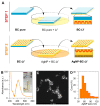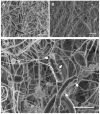Two-Sided Antibacterial Cellulose Combining Probiotics and Silver Nanoparticles
- PMID: 34064907
- PMCID: PMC8151946
- DOI: 10.3390/molecules26102848
Two-Sided Antibacterial Cellulose Combining Probiotics and Silver Nanoparticles
Abstract
The constant increase of antibiotic-resistant bacteria demands the design of novel antibiotic-free materials. The combination of antibacterials in a biocompatible biomaterial is a very promising strategy to treat infections caused by a broader spectrum of resistant pathogens. Here, we combined two antibacterials, silver nanoparticles (AgNPs) and living probiotics (Lactobacillus fermentum, Lf), using bacterial cellulose (BC) as scaffold. By controlling the loading of each antibacterial at opposite BC sides, we obtained a two-sided biomaterial (AgNP-BC-Lf) with a high density of alive and metabolically active probiotics on one surface and AgNPs on the opposite one, being probiotics well preserved from the killer effect of AgNPs. The resulting two-sided biomaterial was characterized by Field-Emission Scanning Electron Microscopy (FESEM) and Confocal Laser Scanning Microscopy (CLSM). The antibacterial capacity against Pseudomonas aeruginosa (PA), an opportunistic pathogen responsible for a broad range of skin infections, was also assessed by agar diffusion tests in pathogen-favorable media. Results showed an enhanced activity against PA when both antibacterials were combined into BC (AgNP-BC-Lf) with respect to BC containing only one of the antibacterials, BC-Lf or AgNP-BC. Therefore, AgNP-BC-Lf is an antibiotic-free biomaterial that can be useful for the therapy of topical bacterial infections.
Keywords: Ag nanoparticles; antibiotic-resistant bacteria; bacterial cellulose; probiotics.
Conflict of interest statement
The authors declare no conflict of interest.
Figures




References
MeSH terms
Substances
LinkOut - more resources
Full Text Sources
Medical
Molecular Biology Databases

